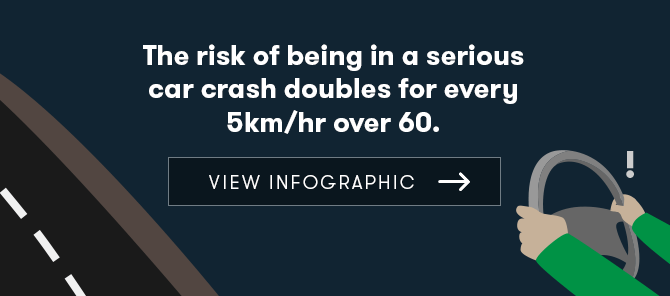Death-defying designs for car safety
Expert reviewers
Essentials
- Despite the increase of both people and vehicles on our roads, driving is safer today than at any time in the past
- 90 per cent of road accidents are the result of human error
- Government agencies and car manufacturers are continually finding ways of enhancing safety on our roads
- Australia’s road toll has fallen consistently since 1970
- Car safety features can only do so much—an alert and engaged driver is still the best way of arriving safely at your destination
Whether you’re a fan of Audi, Volvo, or any of the makes in between, there can be no doubt that Australians love their cars. In July 2014 there were 17.6 million registered motor vehicles in Australia, with the average driver travelling over 15,500 kilometres in a year. There are more people and more cars on the road than ever before, yet the number of road deaths continues to decrease each year. Why is this so?
The answer is due to a number of factors including improved road design, driver education programs, strengthening and enforcing the laws governing road use, and of course, improvements in car safety.

Car safety in Australia is regulated by the Australian Design Rules (ADRs)—national standards for vehicle safety, anti-theft and emissions. The standards cover issues such as structure, occupant protection, braking, lighting, noise, engine exhaust and other minor items. The standards apply to all vehicles manufactured in Australia or imported as new or second hand for purchase in the market.
In addition to the ADRs, the Australasian New Car Assessment Program (ANCAP) undertakes rigorous safety testing of vehicles available on the Australian market and awards a safety rating to each vehicle. Cars given five stars are Consumers can check the safety score when deciding which car to buy.
Most modern cars have safety features divided into three categories:
- Crash avoidance features
- Crash protection features
- Driver features
Let’s take a closer look at some of the innovations in these categories.
Crash avoidance
Crash avoidance features are those that help you avoid being involved in a crash in the first place, such as traction control, auto-emergency braking and electronic stability control.
Electronic stability control (ESC)
Electronic stability control (ESC) reduces the chance of skidding or losing control of a car as a result of over-steering. When sensors in the vehicle detect any loss of control, the system activates, using computer controlled technology to apply individual brakes to the relevant wheels help stabilise the car and bring it back on track, without fishtailing all over the road.
Research conducted in Australia has found that ESC reduces the risk of single car crashes by 25 per cent and single 4WD crashes by 51 per cent. ESC is known by different names, including Electronic Stability Program (ESP), Dynamic Stability Control (DSC), and Vehicle Dynamic Control (VDC) amongst others.
ESC can assist drivers to manage sideways (lateral) movements which create instability. It is a holistic system that can work to control a car’s entire movements, rather than just one component.
Traction control
Traction control systems work to improve the grip and stability of a vehicle during acceleration. Electronic sensors measure wheel rotation and, when discrepancies are noted (ie that one wheel is spinning faster than another), the system automatically engages, reducing engine power or temporarily applying the brake to that wheel, reducing its speed and preventing (or at least lessening) wheel-slip. Despite the name, Traction Control cannot create traction where there is none, it simply helps cars maximise the traction that is available on any given surface.
Cars with ESC will have traction control, but not all cars with traction control have ESC.
Auto Emergency Braking (AEB)
Auto Emergency Braking (AEB) works to prevent a crash or reduce the impact speed in an accident. The system can activate both with and without driver intervention. Using data collected from forward-looking radars, sensors, lasers, cameras or video systems, AEB can create an accurate ‘real-time’ image of the road ahead. If a driver does not respond to a hazard, the system will provide an audible or visual warning to the driver, and can apply brake pressure automatically, with maximum brake power implemented when the driver does engage the brakes. If the system determines that the driver’s steering and braking response is not adequate to avoid impact, autonomous emergency braking with maximum pressure will be automatically applied to help minimise the impact.
An AEB simulation project undertaken in Australia in 2013 estimated that AEB had the potential to reduce fatal crashes by 20–25 per cent and injury crashes by as much as 35 per cent. Further data collected on the effectiveness of AEB indicate that 53 per cent of all rear-end collisions could be mitigated in crash severity and 35 per cent of rear end crashes could be avoided completely with the use of AEB.
Many Australian car manufacturers now include some form of AEB in their vehicles. As with ESC, it can be known by a range of different names, including Collision Mitigation Braking System, Smart City Brake Support and Active City Stop.
Anti-lock brakes
The purpose of an anti-lock braking system (ABS) is to help the driver avoid a hazard by providing steering control in nearly all circumstances. Confronted with an impending disaster, many drivers apply maximum braking pressure, locking all wheels and initiating an uncontrollable slide. Sliding front tyres cannot steer a car, while sliding rear wheels may cause the car to unintentionally rotate. Unless the driver regains composure and releases the brakes, the car will continue to slide in the original direction until impact.
ABS brakes release pressure on the brake of any wheel when that wheel decelerates to the point when it begins to lock. The outcome is that the driver is assured of a considerable degree of directional control of the vehicle.
The system works simply enough. Sensors located on each wheel are monitored by a computer called a controller. Just before the wheel locks it will experience a rapid deceleration, or loss of speed. This is noted by the controller, which opens a valve to release pressure on the brake, thus allowing the wheel to keep moving. The pressure is then quickly reapplied (otherwise the car wouldn’t be brought to a stop) but eased whenever the wheel is about to lock. In this way, the wheels and the car are brought to a stop without ever dragging or sliding the tyres with respect to the ground. The driver applying the brakes in an emergency will feel a pulsing in the brake pedal, which is the result of the alternate increasing and decreasing of pressure on the brakes by the controller. So the speed of the car will be rapidly decreasing, but the driver will still be able to maintain some steering ability.
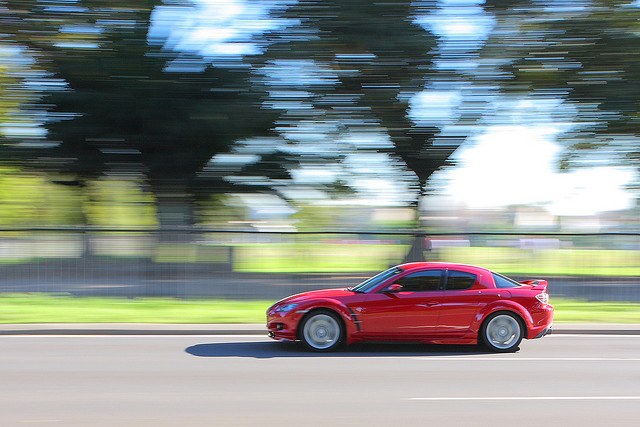
Crash protection features
Even the best crash-avoidance systems can’t mitigate the fact that humans are the ones driving the car. For this reason, accidents still happen. Traffic accident researchers estimate that approximately 90 per cent of all crashes involve some form of human error. To accommodate this, modern cars now come equipped with a range of crash protection features, which will help save your life if you are unlucky enough to be involved in a crash.
Crumple zones
We expect our cars to be strong and safe, but ‘weakness’ can also be a strength. Modern cars are now manufactured with ‘crumple zones’—specific areas designed to collapse and change shape on impact in order to absorb and redistribute as much of the crash energy as possible. The cabin of the vehicle remains a rigid structure, working to stay intact and protect the passengers while the crumple zones are damaged instead.
The idea of crumple zones was first derived in 1959 by Bela Barenyi, an engineer working for Daimler-Benz who questioned whether a rigid vehicle was inherently a safe vehicle (the answer is no).
Crumple zones vary from car to car—they can be made to withstand a large impact (such as that experienced by a racing vehicle), or to withstand a smaller impact, typical of a general-use road car.
Crumple zones act like the cardboard boxes used in movie stunts to break a fall. As the stuntman falls he gains kinetic energy; if he was to hit solid ground, most of that energy would be absorbed by his body in a very short time, with possibly fatal consequences. However, a well-designed stunt will ensure that the stuntman lands on a stack of cardboard boxes; the impact energy will then be used to collapse the boxes instead of to damage the stuntman. Similarly, the purpose of car crumple zones is to minimise the amount of crash energy transferred to passengers when a vehicle collides with a solid object.
Newton’s Second Law of Motion states that force is equal to mass multiplied by acceleration. So, if acceleration and force are proportionate, then when acceleration is halved the magnitude of force will also be halved. Crumple zones are therefore designed to reduce the deceleration of a vehicle, resulting in a corresponding reduction of force exerted on the vehicle. The way in which crumple zones collapse also increases the time it takes for a car to come to a complete stop, resulting in a corresponding reduction in the magnitude of deceleration.
Other improvements in car design safety include such things as strength and stiffness requirements for side-doors to help protect occupants in a side impact; collapsible steering columns to minimise the risk of crushing or piercing injuries from a frontal impact; anti-burst door locks; and padding on instrument panels.
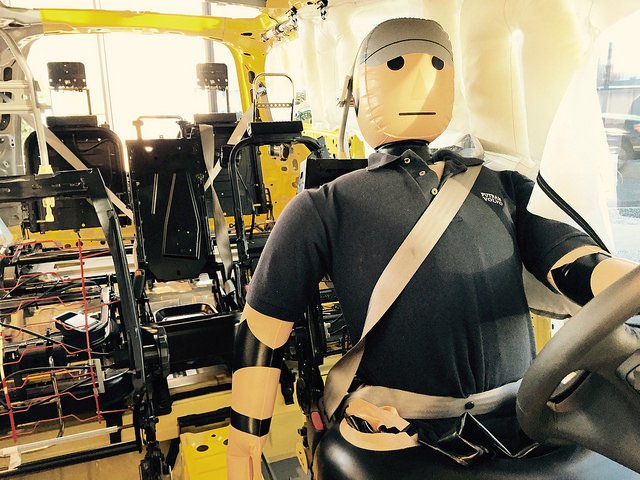
The heroic seatbelt
Reach—Pull—Click. It really is that easy. Seatbelts are one of the quickest, simplest and most effective safety features used in modern transport.
It is no coincidence that the decline in Australian road deaths commenced in earnest in the years following the introduction in the early 1970s of compulsory seatbelt laws in all Australian states and territories.
Car accident researchers in Australia estimate that seatbelt use reduces the risk of fatal or serious injury by at least 50 per cent. Despite the known benefits of seatbelt use, 1 in 5 deaths on Australian road deaths is still the result of failure to buckle up.
It was just a matter of finding a solution that was simple, effective and could be put on conveniently with one hand.Nils Bohlin, creator of the modern three-point seatbelt
Airbags
Airbags are a more recent addition to the armoury against road trauma. Most commonly, these are located in the centre of the steering wheel and above the glove-box on the passenger side, while some cars also have side airbags located in the doors. Airbags are designed to activate almost instantaneously on impact to form a ‘cushion’ as the head and chest of the driver or passenger flex forward. However, they are not the soft, comforting pillow often shown on TV commercials.
According to the Australian Government Department of Transport and Regional Services, this is what happens when an airbag deploys in a crash:
- In the 15 to 20 milliseconds after impact, the crash sensors and control unit determine the severity of the collision and decide whether to deploy the airbag
- At about 25 milliseconds, the airbag splits its covering pad in predetermined places and begins to inflate rapidly
- At about 45 milliseconds, the bag is fully inflated while the seatbelted occupant is still moving forward
- At around 60 milliseconds, the occupant contacts the airbag, which immediately begins to deflate via vent holes in the back
- Up to 100 milliseconds, the occupant continues to sink deeply into the airbag, which cushions the head and chest while it is deflating
Airbags are deployed at a speed of around 200km/h, a lot faster than most cars are travelling, and the whole sequence listed above is over in under a second. The force of this deployment can cause some injuries such as grazes, bruising or potentially burst eardrums, but these injuries are far less serious than those that could have occurred had an airbag not been present.
The airbag therefore functions in much the same way as the stuntman’s cardboard boxes—it helps absorb impact while also acting as a barrier between the occupant and the hard, less forgiving surfaces of the car interior.
Like the seatbelt, airbags are widely credited with saving lives—US statistics suggest that the risk of fatality in a frontal impact is reduced by about 30 per cent by the deployment of an airbag. Crash tests in Australia indicate that the risk of serious head injury is reduced by 50 per cent or more in most popular makes of family-sized car.
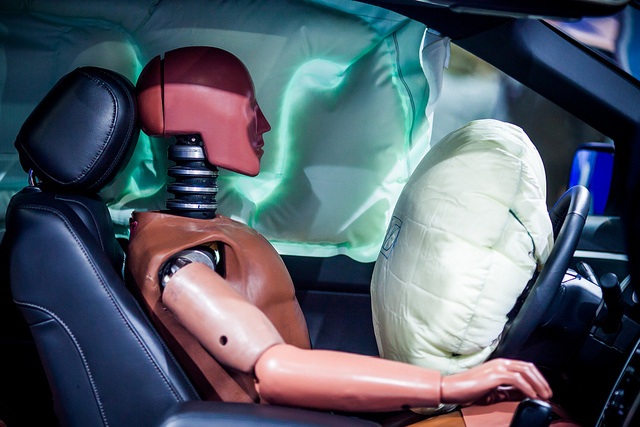
Airbag hazard?
An airbag is designed to be fully inflated by the time the occupant’s head makes contact with it. Anything else would be dangerous: a collision between a head, moving at high velocity in one direction, and the bag, moving at a similar speed in the other, could be fatal. And accidents do happen—airbags have been implicated in some deaths in the United States. Since car occupants there are less inclined to wear seatbelts, the airbags are designed to inflate more quickly—and thus with more force—than those used in Australia. Australian researchers have found no evidence of death or injury caused by airbag deployment in over 100 investigated cases.
Airbags can be dangerous to children and small adults—even when they are restrained by adult seatbelts—if they sit too close to the airbag or are not seated correctly when the airbag inflates. Moreover, rearward facing ‘cradle’ or capsule-type infant restraints should never be placed in a front passenger seat that is fitted with an airbag. In the event of a crash, the baby's head would be within the ‘strike’ zone of the airbag and the impact could lead to fatal head injuries. All occupants of cars with fitted airbags need to be aware of the potential danger and ensure they are seated correctly. In Australia, children and infants are more often buckled into the rear seat, which is much safer.
Despite the potential hazard, airbags have proved both effective and popular. Some makes and models of cars now have side airbags to help prevent injury to the head and shoulders caused by side impacts—which account for about one-quarter of all crash injuries and 28 per cent of deaths.
Driver Education
Road safety campaigns
Awareness campaigns that educate drivers about safer driving practices have also played a large part in reducing deaths on the road. These ads can be both confronting and controversial in getting their message across. Over the years, Australian road safety campaigns have addressed the issues of drunk driving, speeding, seatbelts, driver fatigue and the dangers of using mobile phones or other technology while at the wheel.
In 2016, the Transport Accident Commission (TAC) took a different approach, commissioning artist Patricia Piccinini to create a sculpture showing how our bodies might look if we were built to survive a crash on the road. The result was Graham, who it is hoped will become a catalyst for conversation and an educational tool, reminding us that despite all the new technology in our cars, our bodies are still human, and therefore still vulnerable.
These campaigns aim to educate drivers to change their behaviour on the road and to be aware of the potential consequences of driving recklessly.
The effectiveness of these campaigns has been complemented by additional enforcement techniques, such as random breath testing, red light and speed cameras (roaming, fixed and point-to-point) increased monetary fines, and higher insurance premiums for offenders.
Drivers gaining a greater understanding of the potential impact of their behaviour, coupled with the threat of substantial fines, has certainly contributed to a lower road toll.
Driver features
Driver features improve the safety of a vehicle by making the driving experience easier and more comfortable. They include extras that at first glance may seem unnecessary or purely for show, but can in fact play an important part in reducing the likelihood of accidents. By making driving a more comfortable and enjoyable experience, they reduce the level of physical and mental fatigue experienced by drivers, allowing them to remain alert for longer. Driver features include:
- adjustable seats
- adjustable steering columns
- variable dashboard lighting
- speed alerts
- fatigue detection and reminders
- head rests
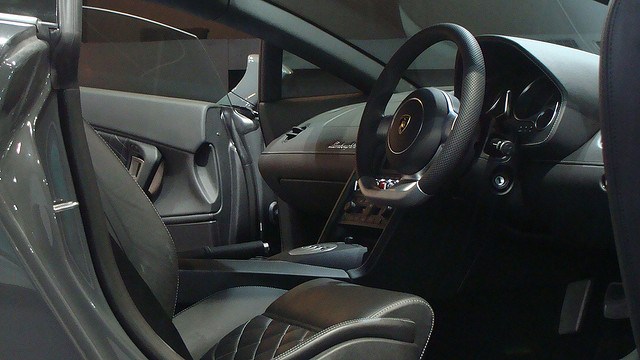
Safer cars still aren't perfect
Is there a downside to all this safety?
Any reduction in the road death toll is a good thing. However, an interesting trend over the last few years has emerged—while the death toll is decreasing, the rate of serious injury is increasing. Experts believe this may be because the occupants of modern cars are surviving crashes that would have been fatal several years ago.
The Australian Automobile Association (AAA) has estimated that the annual number of people suffering serious injury as a result of a road crash is more than 30 times the number of people killed on our road. It has calculated this figure to be around 32,500 people seriously injured on Australian roads each year. Many of these injuries require extensive rehabilitation and can cause long-term physical and mental impairment.
The financial cost of all these deaths and injuries has been estimated at $27 billion per year, and this is not taking in to account the enormous social impact of the crash on a victim’s family.
Conclusion
The strategic strengths and weaknesses that manufacturers are now building into their cars, along with traditional safety devices such as the seatbelt, airbag and ABS, are the result of scientific and technological innovation, as well as considerable investment by car-makers. They are making cars safer and we can look forward to more improvements in the future. For example, 'smart' airbags and seatbelts that adjust the rate of inflation of the bag or tension on the belt according to the weight of the person are becoming available, and Volvo has recently developed a seat designed to reduce whiplash in rear-end collisions. Electronic Date Recorders (EDR), similar to an aircraft’s ‘black box’, record information that can be analysed in the event of a crash, while Smart keys will allow you to set operating restrictions (maximum speed, time of day use) on a vehicle.
But for all the wonderful technological advances in car safety, none is as effective as an alert, engaged driver who is aware of the conditions and driving accordingly.






